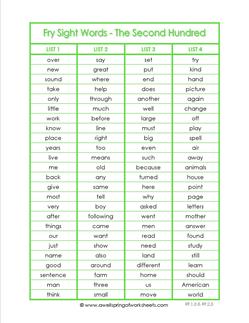

So, while there are many more words on the Fry lists and it will obviously take longer for students to master them all, doing so will dramatically increase their fluency and comprehension. Just like the words on the Dolch lists, some of these are regular, or decodable words, and some are irregular, or non-decodable, words as well as being high-frequency words that children will encounter often while reading and writing. Fry Sight WordsĪs I pointed out above, the Fry sight words are made up of 1,000 common words, nouns included, and these words are broken up into ten different groups or lists. Edward Fry in 1957 and then updated again in 1980.Īnd while the main Dolch lists consist of just 220 words, the Fry sight words list is comprised of 1,000 of the most commonly found words in print, and students that master all 1,000 words will know roughly 90% of the words that they come across in their daily reading and writing. The Fry sight words, on the other hand, were first compiled by Dr. Learn the second one hundred Fry instant sight words These are the most frequently used used words in reading and writing.Looking for a kids' channel that's. Well, the Dolch list was first compiled and published in 1936 and hasn’t really been updated since.

Now, I’ve written about the Dolch lists before and you can more about those here, but personally, I prefer to teach the Fry lists as I feel that they are more comprehensive and have been updated more recently than the Dolch lists. While I’m sure that you could find a million different sight word lists on the internet today that have compiled several different high-frequency words, the Fry and Dolch lists are probably the most well-known and the most commonly used.ĭeciding to use one over the other is more often than not a matter of personal preference.


 0 kommentar(er)
0 kommentar(er)
